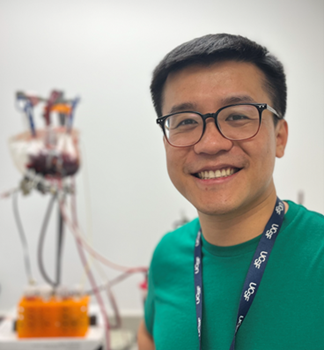Welcome to the Yang Lab

Heiko Yang, MD, PhD
Research Interests
The primary goal of my lab is to explore kidney biology using normothermic ex vivo perfusion. Sustaining human and porcine kidneys in a physiologic state outside the body provides a unique opportunity to study complex intercellular interactions, tease apart organ autonomous processes, and test organ-directed therapeutics.
Active Research Projects
Long-term Normothermic Ex Vivo Kidney Perfusion
The current limit to normothermic ex vivo kidney perfusion is 24 hours. Extending beyond this limit would greatly increase the value of normothermic ex vivo kidney perfusion as a research tool to model kidney biology and as a clinical tool to extend the longevity of donor organs. To accomplish this, we will need to systematically define and overcome the technical and biological barriers that limit ex vivo kidney perfusion. We are thus working iteratively to extend the longevity of ex vivo kidney perfusion using our custom platform, and we have developed a porcine renal autotransplantion protocol to evaluate in vivo function of the kidney following ex vivo perfusion.
Whole-organ Gene Editing in the Kidney
There are more than 500 monogenic causes of human kidney disease. Our long-term goal is to develop a kidney-directed gene editing strategy that can durably halt the progression of renal failure and provide a cure for such diseases. Understanding how to best target the kidney is a major challenge in gene therapy. Given the numerous technical and biological challenges associated with the development of targeted in vivo delivery (e.g. liver accumulation, off-target effects, and toxicity), we hypothesize that an ex vivo approach could be more effective. We envision that the future of kidney-directed gene therapy involves surgically removing a patient's diseased kidney, performing gene editing of the kidney during ex vivo perfusion, and then implanting the genetically modified kidney back into the patient. The surgical aspects of this strategy are well-established; our present challenge is to determine how to perform gene editing in the kidney ex vivo.
Blood Substitutes and Alternative Oxygen Carriers for Organ Perfusion
There is a great need to develop an alternative to red blood cells as a life-sustaining oxygen carrier due to the scarcity of donor red blood cells (RBCs), their limited lifespan in storage (< 42 days at 4C), and contraindications that prohibit their use in many settings. Prior and ongoing attempts to use hemoglobin-based oxygen carriers (HBOCs) such as polymerized or lipid-encapsulated hemoglobin have had muted success to date as these products are unstable and costly to produce. To overcome this challenge, we have identified a naturally occurring acellular oxygen carrier that holds promise due its molecular stability, favorable oxygen-binding profile, and natural abundance. We aim to use normothermic ex vivo kidney perfusion to evaluate the organ-sustaining properties of this material and optimize a formulation for kidney perfusion. These studies will lead to the development of a blood substitute for organ perfusion. The eventual goal will be to further develop its use for life-saving transfusions.
Publications
Loading items....